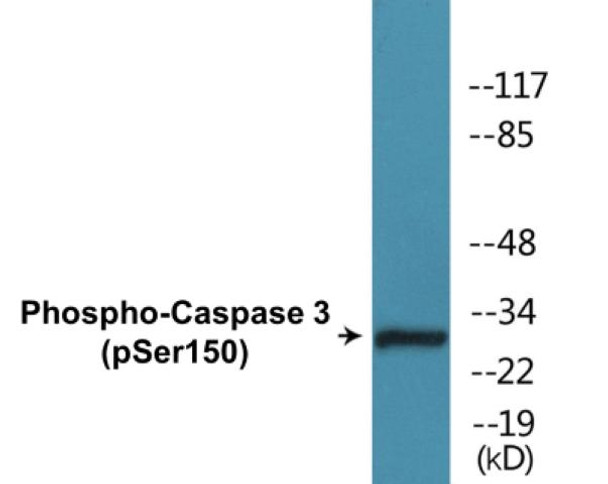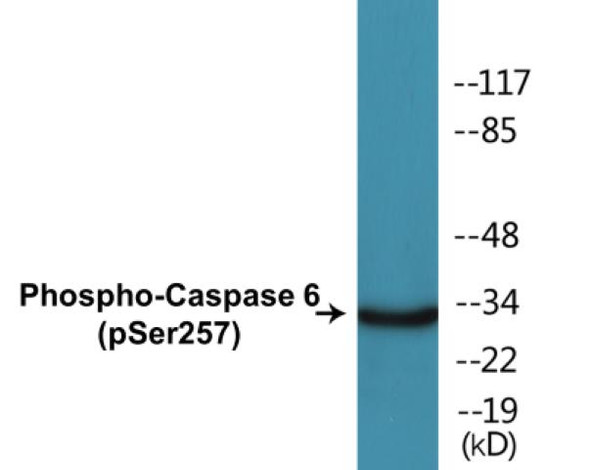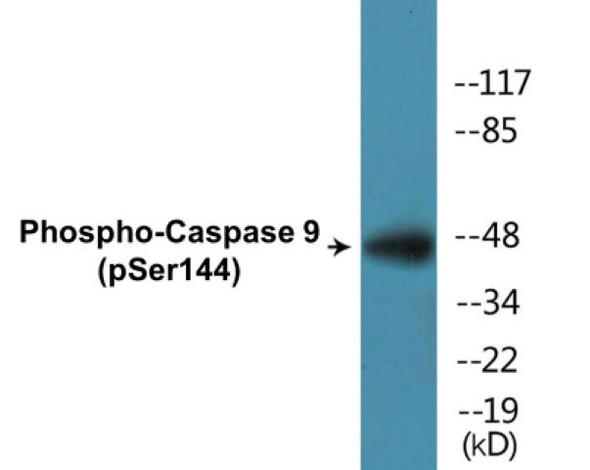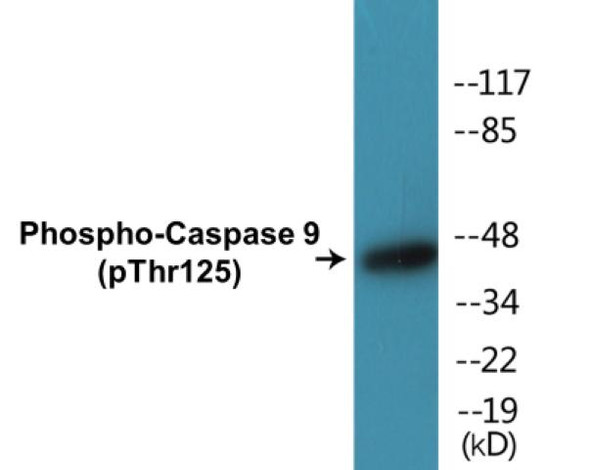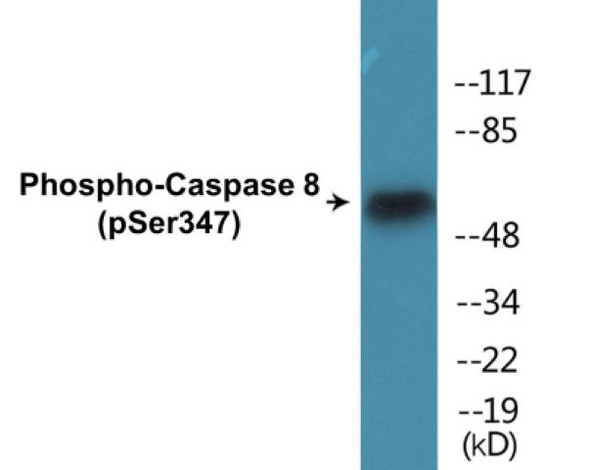Caspase 3 (Phospho-Ser150) Colorimetric Cell-Based ELISA Kit
- SKU:
- CBCAB00441
- Product Type:
- ELISA Kit
- ELISA Type:
- Cell Based Phospho Specific
- Research Area:
- Cell Death
- Reactivity:
- Human
- Mouse
- Rat
- Detection Method:
- Colorimetric
Description
Caspase 3 (Phospho-Ser150)Colorimetric Cell-Based ELISA Kit
The Caspase-3 Phospho-Ser150 Colorimetric Cell-Based ELISA Kit is a powerful tool for researchers looking to accurately measure levels of phosphorylated caspase-3 in cell lysates. This kit offers high sensitivity and specificity, ensuring precise and reproducible results for a variety of research applications.Caspase-3 is a key enzyme involved in the process of programmed cell death, or apoptosis. Phosphorylation of caspase-3 at serine 150 can modulate its activity and sensitivity to apoptotic signals, making it a crucial marker for studying cell death pathways and potential therapeutic interventions.
By using the Caspase-3 Phospho-Ser150 Colorimetric Cell-Based ELISA Kit, researchers can gain valuable insights into the regulation of apoptosis and identify potential targets for drug development in conditions such as cancer, neurodegenerative diseases, and inflammatory disorders. This kit is an essential tool for advancing our understanding of cell death mechanisms and developing novel treatment strategies.
| Product Name: | Caspase 3 (Phospho-Ser150) Colorimetric Cell-Based ELISA |
| Product Code: | CBCAB00441 |
| ELISA Type: | Cell-Based |
| Target: | Caspase 3 (Phospho-Ser150) |
| Reactivity: | Human, Mouse, Rat |
| Dynamic Range: | > 5000 Cells |
| Detection Method: | Colorimetric 450 nm |
| Format: | 2 x 96-Well Microplates |
The Caspase 3 (Phospho-Ser150) Colorimetric Cell-Based ELISA Kit is a convenient, lysate-free, high throughput and sensitive assay kit that can detect Caspase 3 protein phosphorylation and expression profile in cells. The kit can be used for measuring the relative amounts of phosphorylated Caspase 3 in cultured cells as well as screening for the effects that various treatments, inhibitors (ie. siRNA or chemicals), or activators have on Caspase 3 phosphorylation.
Qualitative determination of Caspase 3 (Phospho-Ser150) concentration is achieved by an indirect ELISA format. In essence, Caspase 3 (Phospho-Ser150) is captured by Caspase 3 (Phospho-Ser150)-specific primary antibodies while the HRP-conjugated secondary antibodies bind the Fc region of the primary antibody. Through this binding, the HRP enzyme conjugated to the secondary antibody can catalyze a colorimetric reaction upon substrate addition. Due to the qualitative nature of the Cell-Based ELISA, multiple normalization methods are needed:
| 1. | A monoclonal antibody specific for human GAPDH is included to serve as an internal positive control in normalizing the target absorbance values. |
| 2. | Following the colorimetric measurement of HRP activity via substrate addition, the Crystal Violet whole-cell staining method may be used to determine cell density. After staining, the results can be analysed by normalizing the absorbance values to cell amounts, by which the plating difference can be adjusted. |
| Database Information: | Gene ID: 836, UniProt ID: P42574, OMIM: 600636, Unigene: Hs.141125 |
| Gene Symbol: | CASP3 |
| Sub Type: | Phospho |
| UniProt Protein Function: | CASP3: Involved in the activation cascade of caspases responsible for apoptosis execution. At the onset of apoptosis it proteolytically cleaves poly(ADP-ribose) polymerase (PARP) at a '216-Asp-|-Gly-217' bond. Cleaves and activates sterol regulatory element binding proteins (SREBPs) between the basic helix-loop- helix leucine zipper domain and the membrane attachment domain. Cleaves and activates caspase-6, -7 and -9. Involved in the cleavage of huntingtin. Triggers cell adhesion in sympathetic neurons through RET cleavage. Heterotetramer that consists of two anti-parallel arranged heterodimers, each one formed by a 17 kDa (p17) and a 12 kDa (p12) subunit. Interacts with BIRC6/bruce. Highly expressed in lung, spleen, heart, liver and kidney. Moderate levels in brain and skeletal muscle, and low in testis. Also found in many cell lines, highest expression in cells of the immune system. Inhibited by isatin sulfonamides. Belongs to the peptidase C14A family. |
| UniProt Protein Details: | Protein type:Protease; EC 3.4.22.56; Apoptosis; Motility/polarity/chemotaxis Chromosomal Location of Human Ortholog: 4q34 Cellular Component: nucleoplasm; plasma membrane; nucleus; cytosol Molecular Function:peptidase activity; cyclin-dependent protein kinase inhibitor activity; protein binding; cysteine-type endopeptidase activity; aspartic-type endopeptidase activity Biological Process: extracellular matrix organization and biogenesis; nerve growth factor receptor signaling pathway; apoptosis; positive regulation of apoptosis; heart development; negative regulation of activated T cell proliferation; negative regulation of B cell proliferation; regulation of caspase activity; proteolysis; neuron differentiation; extracellular matrix disassembly; sensory perception of sound; B cell homeostasis; positive regulation of neuron apoptosis; response to wounding; erythrocyte differentiation; T cell homeostasis; DNA fragmentation during apoptosis; cell structure disassembly during apoptosis; response to UV; release of cytochrome c from mitochondria; cell fate commitment; negative regulation of cyclin-dependent protein kinase activity; keratinocyte differentiation; neuron apoptosis; induction of apoptosis via death domain receptors; caspase activation via cytochrome c; platelet formation; induction of apoptosis by oxidative stress; response to DNA damage stimulus; negative regulation of apoptosis |
| NCBI Summary: | This gene encodes a protein which is a member of the cysteine-aspartic acid protease (caspase) family. Sequential activation of caspases plays a central role in the execution-phase of cell apoptosis. Caspases exist as inactive proenzymes which undergo proteolytic processing at conserved aspartic residues to produce two subunits, large and small, that dimerize to form the active enzyme. This protein cleaves and activates caspases 6, 7 and 9, and the protein itself is processed by caspases 8, 9 and 10. It is the predominant caspase involved in the cleavage of amyloid-beta 4A precursor protein, which is associated with neuronal death in Alzheimer's disease. Alternative splicing of this gene results in two transcript variants that encode the same protein. [provided by RefSeq, Jul 2008] |
| UniProt Code: | P42574 |
| NCBI GenInfo Identifier: | 77416852 |
| NCBI Gene ID: | 836 |
| NCBI Accession: | P42574.2 |
| UniProt Secondary Accession: | P42574,Q96AN1, Q96KP2, A8K5M2, D3DP53, |
| UniProt Related Accession: | P42574 |
| Molecular Weight: | 277 |
| NCBI Full Name: | Caspase-3 |
| NCBI Synonym Full Names: | caspase 3, apoptosis-related cysteine peptidase |
| NCBI Official Symbol: | CASP3 |
| NCBI Official Synonym Symbols: | CPP32; SCA-1; CPP32B |
| NCBI Protein Information: | caspase-3; CASP-3; CPP-32; apopain; procaspase3; protein Yama; PARP cleavage protease; cysteine protease CPP32; SREBP cleavage activity 1; caspase 3, apoptosis-related cysteine protease |
| UniProt Protein Name: | Caspase-3 |
| UniProt Synonym Protein Names: | Apopain; Cysteine protease CPP32; CPP-32; Protein Yama; SREBP cleavage activity 1; SCA-1 |
| Protein Family: | Caspase |
| UniProt Gene Name: | CASP3 |
| UniProt Entry Name: | CASP3_HUMAN |
| Component | Quantity |
| 96-Well Cell Culture Clear-Bottom Microplate | 2 plates |
| 10X TBS | 24 mL |
| Quenching Buffer | 24 mL |
| Blocking Buffer | 50 mL |
| 15X Wash Buffer | 50 mL |
| Primary Antibody Diluent | 12 mL |
| 100x Anti-Phospho Target Antibody | 60 µL |
| 100x Anti-Target Antibody | 60 µL |
| Anti-GAPDH Antibody | 60 µL |
| HRP-Conjugated Anti-Rabbit IgG Antibody | 12 mL |
| HRP-Conjugated Anti-Mouse IgG Antibody | 12 mL |
| SDS Solution | 12 mL |
| Stop Solution | 24 mL |
| Ready-to-Use Substrate | 12 mL |
| Crystal Violet Solution | 12 mL |
| Adhesive Plate Seals | 2 seals |
The following materials and/or equipment are NOT provided in this kit but are necessary to successfully conduct the experiment:
- Microplate reader able to measure absorbance at 450 nm and/or 595 nm for Crystal Violet Cell Staining (Optional)
- Micropipettes with capability of measuring volumes ranging from 1 µL to 1 ml
- 37% formaldehyde (Sigma Cat# F-8775) or formaldehyde from other sources
- Squirt bottle, manifold dispenser, multichannel pipette reservoir or automated microplate washer
- Graph paper or computer software capable of generating or displaying logarithmic functions
- Absorbent papers or vacuum aspirator
- Test tubes or microfuge tubes capable of storing ≥1 ml
- Poly-L-Lysine (Sigma Cat# P4832 for suspension cells)
- Orbital shaker (optional)
- Deionized or sterile water
*Note: Protocols are specific to each batch/lot. For the correct instructions please follow the protocol included in your kit.
| Step | Procedure |
| 1. | Seed 200 µL of 20,000 adherent cells in culture medium in each well of a 96-well plate. The plates included in the kit are sterile and treated for cell culture. For suspension cells and loosely attached cells, coat the plates with 100 µL of 10 µg/ml Poly-L-Lysine (not included) to each well of a 96-well plate for 30 minutes at 37°C prior to adding cells. |
| 2. | Incubate the cells for overnight at 37°C, 5% CO2. |
| 3. | Treat the cells as desired. |
| 4. | Remove the cell culture medium and rinse with 200 µL of 1x TBS, twice. |
| 5. | Fix the cells by incubating with 100 µL of Fixing Solution for 20 minutes at room temperature. The 4% formaldehyde is used for adherent cells and 8% formaldehyde is used for suspension cells and loosely attached cells. |
| 6. | Remove the Fixing Solution and wash the plate 3 times with 200 µL 1x Wash Buffer for five minutes each time with gentle shaking on the orbital shaker. The plate can be stored at 4°C for a week. |
| 7. | Add 100 µL of Quenching Buffer and incubate for 20 minutes at room temperature. |
| 8. | Wash the plate 3 times with 1x Wash Buffer for 5 minutes each time. |
| 9. | Add 200 µL of Blocking Buffer and incubate for 1 hour at room temperature. |
| 10. | Wash 3 times with 200 µL of 1x Wash Buffer for 5 minutes each time. |
| 11. | Add 50 µL of 1x primary antibodies Anti-Caspase 3 (Phospho-Ser150) Antibody, Anti-Caspase 3 Antibody and/or Anti-GAPDH Antibody) to the corresponding wells, cover with Parafilm and incubate for 16 hours (overnight) at 4°C. If the target expression is known to be high, incubate for 2 hours at room temperature. |
| 12. | Wash 3 times with 200 µL of 1x Wash Buffer for 5 minutes each time. |
| 13. | Add 50 µL of 1x secondary antibodies (HRP-Conjugated AntiRabbit IgG Antibody or HRP-Conjugated Anti-Mouse IgG Antibody) to corresponding wells and incubate for 1.5 hours at room temperature. |
| 14. | Wash 3 times with 200 µL of 1x Wash Buffer for 5 minutes each time. |
| 15. | Add 50 µL of Ready-to-Use Substrate to each well and incubate for 30 minutes at room temperature in the dark. |
| 16. | Add 50 µL of Stop Solution to each well and read OD at 450 nm immediately using the microplate reader. |
(Additional Crystal Violet staining may be performed if desired – details of this may be found in the kit technical manual.)

